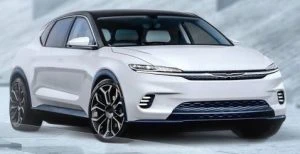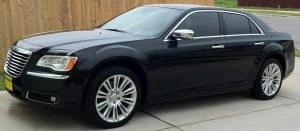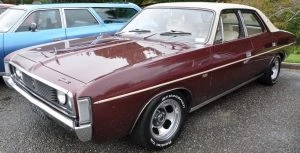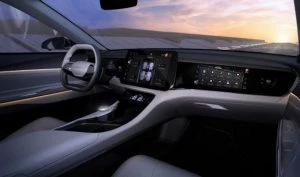Autonomous Vehicles
Autonomous Cars With Eyes?

I’ll make no secret of the fact that I’m not a fan of autonomous cars. For one thing, a lot of people like the feeling of being in charge of where they’re going. For another, well, we’ve all had those moments when other electronic bits and pieces flop and crash, and generally don’t do what they’re supposed to do. An autocorrect fail is not usually life-threatening, and an app that refuses to open won’t kill you. However, we can all imagine what could go wrong with a car that (supposedly) thinks for itself. However, computers don’t get drunk or distracted, so the idea is that autonomous cars will make things safer overall on the roads.
However, among several things that autonomous cars have problems with, shared zones are one of them. Shared zones are those parts of the road where pedestrians and cars can share the same space. They’re usually found in commercial areas of town with lots of shops and eateries. You’ve probably used one of these at some point – I know I have. The thing with these spaces is that the issue of who gives way to whom is often sorted out through a complex series of gestures and eye contact between drivers and passengers. For example, if I’m the driver going through one of these shared zones, I can see a person on the side of the road who looks like they want to cross my path, make eye contact with him or her, then tell him or her to go first with a wave of my hand or a jerk of my head – and the pedestrian may do the same, or accept the offer to go first with a nod, a smile, a thumbs-up… or just stepping out.
The problem is that autonomous cars just aren’t equipped for this. Part of the problem is that they can’t cope with body language and all the subtle nuances that humans can do without thinking. We’re good at this sort of thing. However, another part of the problem, according to some Japanese researchers, is that pedestrians don’t know if the car is “looking” in their direction or is about to move in a certain direction. Indicators and brake lights help, but they can only convey big-picture information: left, right and stop. With cars driven by humans, the drivers do subtle things that suggest they’re about to do something, which another human can pick up on, such as inching forwards, adjusting positioning on the road prior to making a move. However, autonomous cars just do it, like the Nike ad.
What if cars could somehow make eye contact with pedestrians and telegraph what they’re about to do and/or let pedestrians know that the car has “seen” the pedestrian? Well, it’s being tried by some Korean researchers, who have decided that the solution is to give autonomous cars big googly eyes. It’s called the Gazing Car concept. The idea is that the big eyes will “look” at the part of the road that the sensors are focused on. This means that pedestrians will know if the car has registered their presence or if the car is about to move in that particular direction.
You can see the promo video for the Gazing Car here.
If you watched the video and saw the graph showing the reduction in unsafe crossings, please remember that the trial involved nine guys who crossed the road a combined total of 60 times, so it’s not conclusive and more research will need to be done.
Is this technology likely to be taken up? Given the track record of other whimsical pedestrian safety features (e.g., Tesla’s proposal to have bleating goat noises or farts as the low-speed audio warning sound on its EVs), I’d say it may not catch on. But what do you all think? Are these lights useful, creepy, cute or just plain silly? And am I the only one who thinks that a car with these lights ought to talk as well?
Why You Need To Stay Alert During Winter (Even In A Car With All The Driver Assistance Features)

No review of any car produced from 2010 onwards would be complete without a list, or at least a partial list, of some of the driver aids. Most of us have noticed that cars have become more electronic and have more computer-controlled gadgets (and we may have grumbled about it if we are DIY mechanics who know how to use a spanner but go to pieces when confronted with anything containing a chip). The list of driver aids seems to be getting longer and longer, starting with basic things like rear view cameras and going on to things like traffic sign recognition, lane departure correction and more.
There’s no denying that these aids are very useful – I love the reversing camera we fitted onto our Honda Jazz – but it’s important that we don’t become too reliant on them. Even though it may seem as though the clever people who design these systems and sensors are trying to replicate a horse (autonomous, 360° audio warning system, 210° cameras, voice activation, carbon-neutral, emission-free, running on 100% biofuel and completely biodegradable), one has to remember that your car isn’t actually intelligent – like KITT from Knight Rider – and isn’t a horse, and those sensors and systems can have problems in certain conditions.
These conditions tend to crop up a lot in wintertime – the time when driving is most hazardous. One reason why this happens is because the sensors are located on the outside of the vehicle (obviously). On wet days, mud and slush gets thrown up over your car by other vehicles on the road, and this can obscure the sensor. Even something as simple as condensation can cloud the sensors, not only in its own right but also because the condensation can collect dust and because that condensation can freeze if the temperatures go below zero. This is annoying in the case of cameras but absolutely wreaks havoc on all of the other safety systems that rely on the cameras.
The field of image recognition is a hot one for experts working in the field of AI and smart machines. However, this is because we can do it all the time without thinking about it. That’s why those CAPTCHA “prove you’re not a robot” tests often ask you to select all the squares with images of things like motorbikes and traffic signals. (Some suspect that your answers don’t just prove that you’re human but they’re also used to train computers to recognize these items, which is probably why you’re asked to identify things that a smart car might have to identify.) If you’re paying attention, you can identify an oncoming truck on a rainy day, and you can rely on a range of cues to tell you where the side of the road is. Computers don’t quite have this ability, as rain, hail, snow, slush and fog make things tricky. If your car’s Advanced Driver Assistance Systems (ADAS) have been trained on scenes of, say, traffic signs or lane markings that were taken on sunny days, the system will struggle to recognise a traffic sign that’s obscured by fog, has a possum sitting on top of it, has snow or frost covering some of it, or has been used as a target by someone with a shotgun. ADAS can’t extrapolate where the lanes are from a little glimpse of road that’s otherwise covered by snow or piles of hail.

Systems based on radar, such as pedestrian detection and advance collision warning systems also have trouble in cold, wet windy weather. Although fog and frost aren’t a problem for radar, rain, snow and hail are problems. This is because of the way radar works: the radio waves go out, hit something and bounce back, and the time between the signal going out and when it comes back can be used to calculate the distance (or the speed, in the case of police radar systems). However, the radio waves will bounce off anything and be scattered by anything, whether that thing is a hailstone or a heavy truck. Contrary to the rumour going around that radar systems don’t work in the rain, the truth is that they do work – they just don’t work as well. This means that if your car’s ADAS is radar-based, then it might not do quite as good a job on a rainy day.
What this means for you as a driver is that during winter driving conditions, you need to be extra alert – as alert as you would be if you didn’t have all those ADAS in place. For years, we’ve been told that during winter driving conditions, it’s important to slow down and take extra care, and this advice still holds even if your car has all the ADAS bells and whistles. As all car manufacturers are quick to point out, even the fanciest systems are not intended to replace good driving and safety is ultimately the responsibility of the driver.
If you have those sensors and you like to use them (like me and my reversing camera), you may need to wipe them down a bit more often during winter (a paper towel will do the trick). If you’ve got frost on the sensor – which will probably happen if you have frost on your windscreen – then give the sensor a bit of a slosh with the warm water you have probably used to get the ice off your windscreen. Then drive safely!
How 5G Technology is Transforming the Future of Automotive Connectivity

Technology-driven ecosystems are quickly emerging in the automotive industry.
What we expect of a vehicle is evolving – from a tool used to merely move us from point A to B, to an integrated and fully connected tech-hub! Yes, you read that right – and it’s all due to 5G.
5G is becoming an integral part of technological transformation in the automotive industry.
So, to enlighten you about what 5G technology can bring to automotive connectivity, we’ve defined what this technology is and listed some of the key benefits you’ll experience with 5G connected vehicles.
What is 5G technology?
5G is the fifth generation of cellular technology, and it’s set to transform our daily lives by virtually connecting everyone and everything together with faster latency than any previous cellular technology.
Fast-paced, reliable connectivity will allow billions of devices to use and transmit data in more places, bringing major advancements to the IoT (Internet of Things), Virtual Reality (VR), Artificial Intelligence (AI) and more.
How does 5G impact the vehicle industry?
When it comes to automobiles, 5G allows for vehicle-to-vehicle communication in real-time which could deliver reliable connections with lower latency. The reliable and high-volume data transfer enabled by 5G unlocks the potential for V2X (vehicle-to-everything) and V2V (vehicle-to-vehicle) communication – which in turn, unlocks the potential for a variety of features that enhance road safety and convenience for the user.

4 ways 5G network coverage is redefining the driving experience
With the demand for greater connectivity set to soar, 5G-enabled connected cars will become the new norm.
Here are 4 ways 5G will enhance vehicles in the near future:
1. Improved safety
With an increasing number of road fatalities in Australia, safety applications of 5G are of great importance.
Here are some of the applications of 5G in the safety features of cars:
- Speed Control - When connected to the network via 5G, cars can be programmed to automatically adjust speeds based on road closures, congestion or accidents and prepare the driver in advance, avoiding mishaps such as collisions or pileups.
- Alerts - 5G connectivity can be used to detect obstacles by opting to assist in NLOS (non-line-of-sight) scenarios, activate emergency braking warnings, or even crash warnings to avoid accidents.
- Intersection Management - 5G in cars when connected with multiple cameras at intersections can be used to manage traffic better and increase safety.
2. Improved driving experience
Driver demand for connectivity is increasing as people become more familiar with and reliant on the benefits of staying connected.
According to research, around 40% of global consumers would change car brands just to gain more connectivity. Here are some of the applications of 5G in improving your driving experience:
- Navigation - With 5G entering the picture, navigation is likely to get more accurate with real-time map updates and 3D imaging.
- Media - Using the 5G network, connected cars will be able to stream rich HD media content to their infotainment systems directly – which means more entertainment, more often.
3. Efficiency
The 5G network can be used intelligently for delivering value in fleet and commercial vehicles. This can help reduce costs as well as fuel consumption through:
- Route Optimisation - Using real-time maps and traffic data, vehicles can plan faster trips by optimising their routes, therefore reducing the overall cost of travel.
- Platooning - With the help of high-speed networks that operate in real-time, commercial vehicles can drive in a coordinated fashion and maintain a fixed distance between each other, resulting in lower fuel consumption, costs and carbon emissions – all enabled by 5G.
4. Faster freight and shipping
Vehicles that transport our goods will also be getting a makeover thanks to 5G. The logistics industry expects to see faster deliveries and less revenue leakage as a result.
These are some of the projected advancements in the logistics industry:
- Virtual reality road assistance – Companies will be able to manage fleet maintenance using a remote mechanic. This will speed up roadside assistance, getting autonomous trucks back on the road faster to improve delivery times.
- Advanced location tracking – “Dead zones” may become a thing of the past thanks to 5G. With more accurate and advanced geo-location technology, travel delays in remote and rural areas will be easier to track.
The long list of exciting benefits we stand to gain from 5G-connected vehicles is why the future of the automotive industry is infinitely bright. However, the industry requires huge investments to improve network performance and to have a significant impact on the automotive ecosystem.
Ready to drive smarter on the road with a 5G-connected vehicle?
The automotive industry is experiencing changes driven by digital transformation.
So, whenever you’re ready to take the next step towards a 5G-connected car, it helps to have a vehicle expert who can guide you. If you have questions about smart cars and how you can choose the right one for you, simply reach out to us for a chat.
Find the right smart vehicle for you with Private Fleet.
Private Fleet empowers you to gain all the benefits of a fleet purchase, but as a private buyer.
Backed by decades of vehicle industry experience, fleet buying power and a network of car dealers across Australia, we are here to ensure that buying a 5G-connected car will be as straightforward as possible for you.
Buying a new car is a memorable experience – let us make it hassle-free, too.
Reach out to us today for a seamless and easy car-buying experience.
Chrysler Airflow EV Concept

Chrysler Airflow EV Concept
For me, there are two cars in particular I enjoy seeing, and both for which proudly wear the Chrysler badge. I always take the time to admire them every time I walk past one on the street, or I’ll enjoy watching one as it rolls by out on the road. For me, the Chrysler 300 and the Chrysler Valiant are two great looking cars that provide plenty of power, comfort, and a special drive.
The Chrysler 300 came directly out of the American Chrysler line-up, and it offered a gangster-style (chunky, high waistline, plenty of power, large grille) with luxury and comfort, sedan or wagon. The Chrysler Valiant was a full-size car which was sold by Chrysler Australia between 1962 and 1981. To begin with, Chrysler Australia received the Plymouth Valiant from the United States and rebadged it to sell to the Australian market. However, from the second generation, which was launched in 1963, the Valiant was fully manufactured in Australia. The late 70s versions of the Valiant was my favourite.

Chrysler 300

Chrysler Valiant
So, what’s happening in Chrysler’s corner today?
January 2014 saw Fiat S.p.A. announce a deal to purchase the then struggling Chrysler brand, making Chrysler Group a subsidiary of Fiat S.p.A. In May of that year, Fiat Chrysler Automobiles (FCA) was established by merging Fiat S.p.A. By the end of the year, this group was renamed FCA US LLC to reflect the Fiat-Chrysler merger.
In 2021, Stellantis N.V. was formed, which is a multinational automotive manufacturing organization that is made up of a half-and-half merger between the Italian-American company Fiat Chrysler Automobiles (FCA) and the French PSA Group. Stellantis is headquartered in Amsterdam, and, in terms of a global scale, in 2021 Stellantis was rated as being the world’s 5th largest automaker behind Toyota, Volkswagen, Hyundai, and General Motors.
Though at the moment there aren’t a load of new cars with the Chrysler logo coming out, Stellantis is aiming to be an all-electric brand before 2030. At a recent show in America, Stellantis revealed a rather nice-looking Chrysler Airflow concept, suggesting that there is a lot more to come from Chrysler in the future.
Inside the Chrysler Airflow cabin is seating for four. Plenty of recycled materials and vegan leather are just some of the interior features on offer. It is a luxury car with a full panoramic glass roof, ambient lighting, and excellent sound proofing.

Chrysler Airflow EV Concept
Underpinning the new STLA EV platform, Stellantis made the Chrysler Airflow concept a reality, choosing this car for showing off the Airflow’s latest innovative drive-system technology that is fully connected to customer interaction and advanced mobility. The Airflow emphasises Stellantis’ desire to be cutting edge, to keep up with connectivity, and to produce sophisticated digital interaction.
The Chrysler Airflow EV concept boasts STLA Brain and STLA Smart Cockpit technology that connects passengers with their own digital lives. Thus, there are display screens front and rear, which are configured to suit each occupant, and these individual screens can interface with other screens inside the car using sweeping gestures. Each seat has its own camera, which can also be used for video conferencing as well as selfies. The Airflow EV also has autonomous driving capability, with power delivered by two electric motors, one on the front axle and one on the rear axle. Each electric motor on the concept Airflow boasts 150 kW, with a driving range said to be somewhere in the vicinity of 550–650 kilometres.
Certainly, the Chrysler Airflow EV concept is a neat looking Electric Vehicle, with tidy exterior lines, excellent aerodynamics, a long wheelbase, and a wide stance with a low profile. It would be swift, luxurious transport, fitting for the Chrysler brand, and a nod to the Chrysler greats.